Comprehensive Analysis: Economic Downturn Impact on Mysore MFIs
VerifiedAdded on 2019/12/03
|9
|2380
|23
Report
AI Summary
This report examines the impact of economic downturns on microfinance institutions (MFIs) in Mysore. It begins with an overview of MFIs, their significance, and the research objectives, which include evaluating the global economic downturn, assessing MFI growth potential, and identifying the relationship between economic downturns and MFI growth. The literature review explores the growth aspects of MFIs and the trends of economic downturns, particularly focusing on the 2008 financial crisis. The research design and methodology section outlines the types of investigation, data collection methods (including surveys and secondary data), sampling methods, and ethical considerations. The report also addresses data analysis plans, research limitations, and a detailed schedule for the research activities. Key findings highlight the vulnerability of MFIs to economic downturns, the impact of financial crises on their operations, and the importance of economic conditions for their growth and development. The study emphasizes the need for MFIs to adapt to economic fluctuations and the challenges they face in maintaining their services during financial instability.
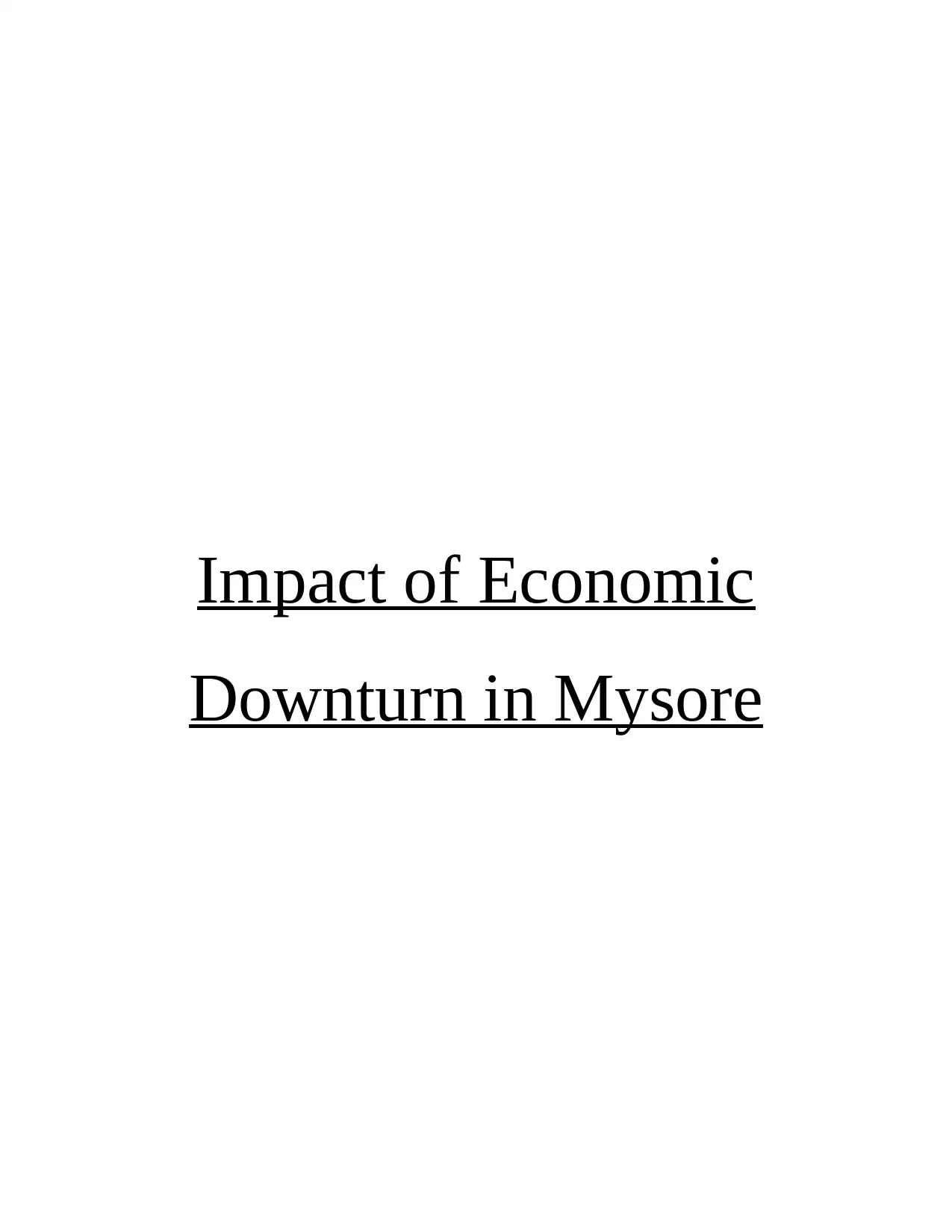
Impact of Economic
Downturn in Mysore
Downturn in Mysore
Paraphrase This Document
Need a fresh take? Get an instant paraphrase of this document with our AI Paraphraser
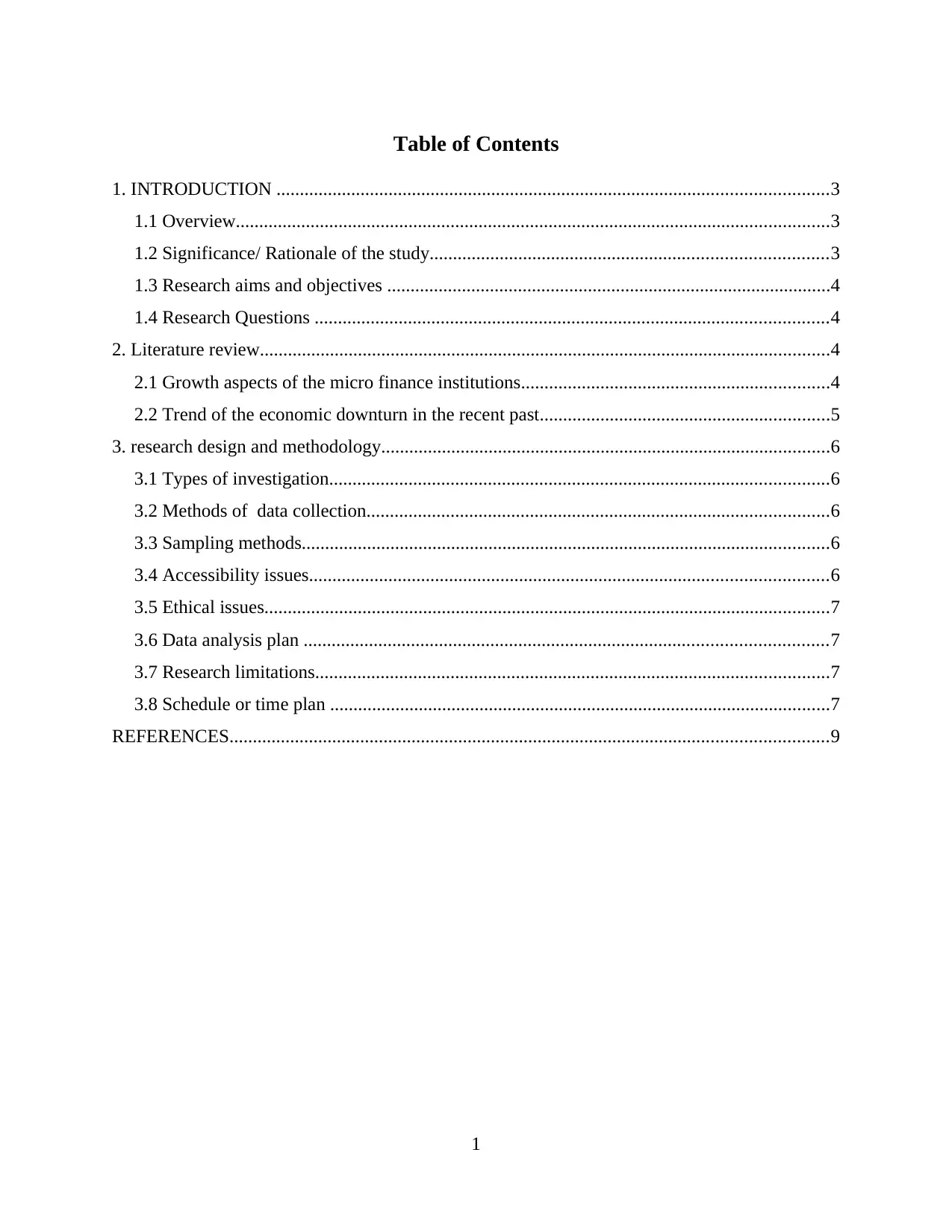
Table of Contents
1. INTRODUCTION ......................................................................................................................3
1.1 Overview...............................................................................................................................3
1.2 Significance/ Rationale of the study.....................................................................................3
1.3 Research aims and objectives ...............................................................................................4
1.4 Research Questions ..............................................................................................................4
2. Literature review..........................................................................................................................4
2.1 Growth aspects of the micro finance institutions..................................................................4
2.2 Trend of the economic downturn in the recent past..............................................................5
3. research design and methodology................................................................................................6
3.1 Types of investigation...........................................................................................................6
3.2 Methods of data collection...................................................................................................6
3.3 Sampling methods.................................................................................................................6
3.4 Accessibility issues...............................................................................................................6
3.5 Ethical issues.........................................................................................................................7
3.6 Data analysis plan ................................................................................................................7
3.7 Research limitations..............................................................................................................7
3.8 Schedule or time plan ...........................................................................................................7
REFERENCES................................................................................................................................9
1
1. INTRODUCTION ......................................................................................................................3
1.1 Overview...............................................................................................................................3
1.2 Significance/ Rationale of the study.....................................................................................3
1.3 Research aims and objectives ...............................................................................................4
1.4 Research Questions ..............................................................................................................4
2. Literature review..........................................................................................................................4
2.1 Growth aspects of the micro finance institutions..................................................................4
2.2 Trend of the economic downturn in the recent past..............................................................5
3. research design and methodology................................................................................................6
3.1 Types of investigation...........................................................................................................6
3.2 Methods of data collection...................................................................................................6
3.3 Sampling methods.................................................................................................................6
3.4 Accessibility issues...............................................................................................................6
3.5 Ethical issues.........................................................................................................................7
3.6 Data analysis plan ................................................................................................................7
3.7 Research limitations..............................................................................................................7
3.8 Schedule or time plan ...........................................................................................................7
REFERENCES................................................................................................................................9
1
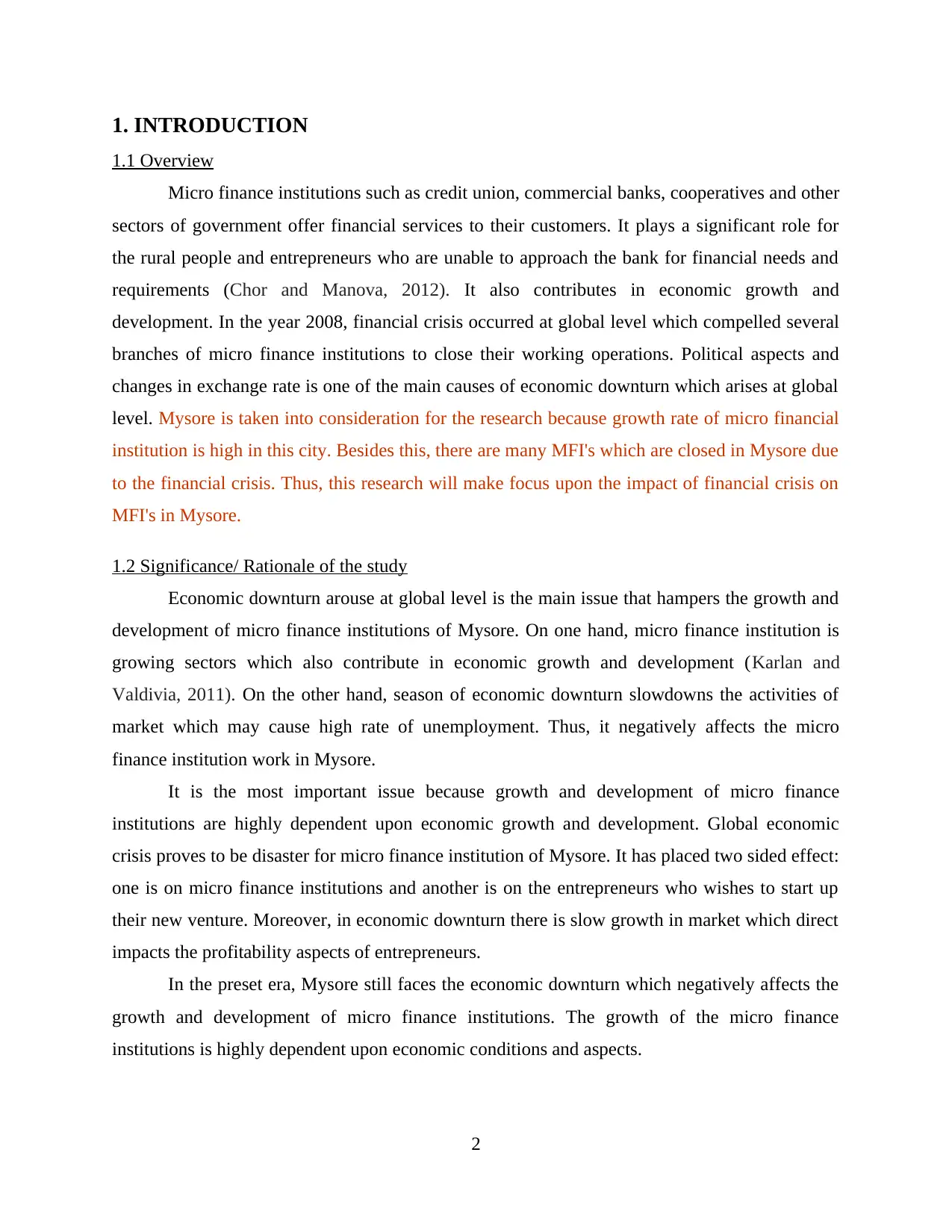
1. INTRODUCTION
1.1 Overview
Micro finance institutions such as credit union, commercial banks, cooperatives and other
sectors of government offer financial services to their customers. It plays a significant role for
the rural people and entrepreneurs who are unable to approach the bank for financial needs and
requirements (Chor and Manova, 2012). It also contributes in economic growth and
development. In the year 2008, financial crisis occurred at global level which compelled several
branches of micro finance institutions to close their working operations. Political aspects and
changes in exchange rate is one of the main causes of economic downturn which arises at global
level. Mysore is taken into consideration for the research because growth rate of micro financial
institution is high in this city. Besides this, there are many MFI's which are closed in Mysore due
to the financial crisis. Thus, this research will make focus upon the impact of financial crisis on
MFI's in Mysore.
1.2 Significance/ Rationale of the study
Economic downturn arouse at global level is the main issue that hampers the growth and
development of micro finance institutions of Mysore. On one hand, micro finance institution is
growing sectors which also contribute in economic growth and development (Karlan and
Valdivia, 2011). On the other hand, season of economic downturn slowdowns the activities of
market which may cause high rate of unemployment. Thus, it negatively affects the micro
finance institution work in Mysore.
It is the most important issue because growth and development of micro finance
institutions are highly dependent upon economic growth and development. Global economic
crisis proves to be disaster for micro finance institution of Mysore. It has placed two sided effect:
one is on micro finance institutions and another is on the entrepreneurs who wishes to start up
their new venture. Moreover, in economic downturn there is slow growth in market which direct
impacts the profitability aspects of entrepreneurs.
In the preset era, Mysore still faces the economic downturn which negatively affects the
growth and development of micro finance institutions. The growth of the micro finance
institutions is highly dependent upon economic conditions and aspects.
2
1.1 Overview
Micro finance institutions such as credit union, commercial banks, cooperatives and other
sectors of government offer financial services to their customers. It plays a significant role for
the rural people and entrepreneurs who are unable to approach the bank for financial needs and
requirements (Chor and Manova, 2012). It also contributes in economic growth and
development. In the year 2008, financial crisis occurred at global level which compelled several
branches of micro finance institutions to close their working operations. Political aspects and
changes in exchange rate is one of the main causes of economic downturn which arises at global
level. Mysore is taken into consideration for the research because growth rate of micro financial
institution is high in this city. Besides this, there are many MFI's which are closed in Mysore due
to the financial crisis. Thus, this research will make focus upon the impact of financial crisis on
MFI's in Mysore.
1.2 Significance/ Rationale of the study
Economic downturn arouse at global level is the main issue that hampers the growth and
development of micro finance institutions of Mysore. On one hand, micro finance institution is
growing sectors which also contribute in economic growth and development (Karlan and
Valdivia, 2011). On the other hand, season of economic downturn slowdowns the activities of
market which may cause high rate of unemployment. Thus, it negatively affects the micro
finance institution work in Mysore.
It is the most important issue because growth and development of micro finance
institutions are highly dependent upon economic growth and development. Global economic
crisis proves to be disaster for micro finance institution of Mysore. It has placed two sided effect:
one is on micro finance institutions and another is on the entrepreneurs who wishes to start up
their new venture. Moreover, in economic downturn there is slow growth in market which direct
impacts the profitability aspects of entrepreneurs.
In the preset era, Mysore still faces the economic downturn which negatively affects the
growth and development of micro finance institutions. The growth of the micro finance
institutions is highly dependent upon economic conditions and aspects.
2
⊘ This is a preview!⊘
Do you want full access?
Subscribe today to unlock all pages.

Trusted by 1+ million students worldwide
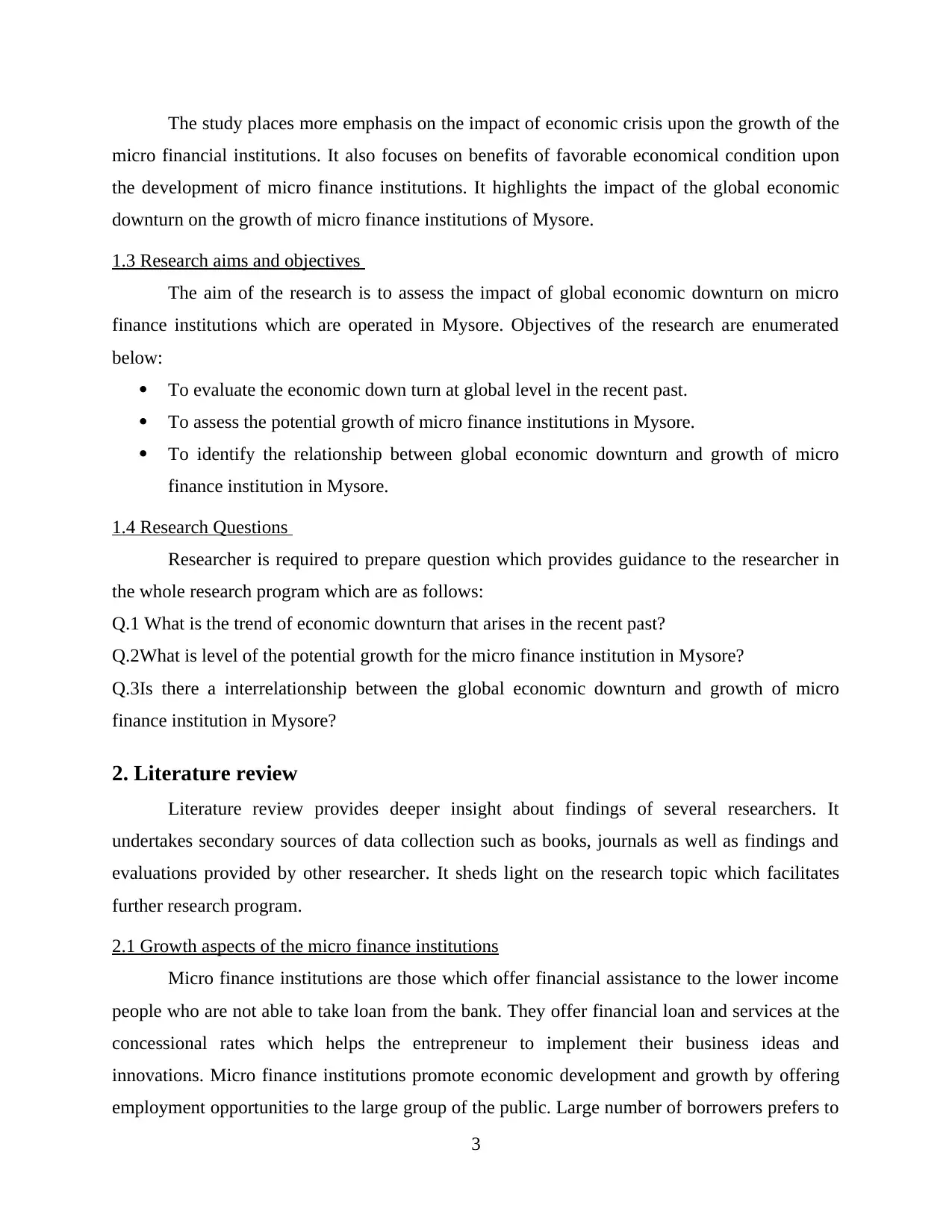
The study places more emphasis on the impact of economic crisis upon the growth of the
micro financial institutions. It also focuses on benefits of favorable economical condition upon
the development of micro finance institutions. It highlights the impact of the global economic
downturn on the growth of micro finance institutions of Mysore.
1.3 Research aims and objectives
The aim of the research is to assess the impact of global economic downturn on micro
finance institutions which are operated in Mysore. Objectives of the research are enumerated
below:
To evaluate the economic down turn at global level in the recent past.
To assess the potential growth of micro finance institutions in Mysore.
To identify the relationship between global economic downturn and growth of micro
finance institution in Mysore.
1.4 Research Questions
Researcher is required to prepare question which provides guidance to the researcher in
the whole research program which are as follows:
Q.1 What is the trend of economic downturn that arises in the recent past?
Q.2What is level of the potential growth for the micro finance institution in Mysore?
Q.3Is there a interrelationship between the global economic downturn and growth of micro
finance institution in Mysore?
2. Literature review
Literature review provides deeper insight about findings of several researchers. It
undertakes secondary sources of data collection such as books, journals as well as findings and
evaluations provided by other researcher. It sheds light on the research topic which facilitates
further research program.
2.1 Growth aspects of the micro finance institutions
Micro finance institutions are those which offer financial assistance to the lower income
people who are not able to take loan from the bank. They offer financial loan and services at the
concessional rates which helps the entrepreneur to implement their business ideas and
innovations. Micro finance institutions promote economic development and growth by offering
employment opportunities to the large group of the public. Large number of borrowers prefers to
3
micro financial institutions. It also focuses on benefits of favorable economical condition upon
the development of micro finance institutions. It highlights the impact of the global economic
downturn on the growth of micro finance institutions of Mysore.
1.3 Research aims and objectives
The aim of the research is to assess the impact of global economic downturn on micro
finance institutions which are operated in Mysore. Objectives of the research are enumerated
below:
To evaluate the economic down turn at global level in the recent past.
To assess the potential growth of micro finance institutions in Mysore.
To identify the relationship between global economic downturn and growth of micro
finance institution in Mysore.
1.4 Research Questions
Researcher is required to prepare question which provides guidance to the researcher in
the whole research program which are as follows:
Q.1 What is the trend of economic downturn that arises in the recent past?
Q.2What is level of the potential growth for the micro finance institution in Mysore?
Q.3Is there a interrelationship between the global economic downturn and growth of micro
finance institution in Mysore?
2. Literature review
Literature review provides deeper insight about findings of several researchers. It
undertakes secondary sources of data collection such as books, journals as well as findings and
evaluations provided by other researcher. It sheds light on the research topic which facilitates
further research program.
2.1 Growth aspects of the micro finance institutions
Micro finance institutions are those which offer financial assistance to the lower income
people who are not able to take loan from the bank. They offer financial loan and services at the
concessional rates which helps the entrepreneur to implement their business ideas and
innovations. Micro finance institutions promote economic development and growth by offering
employment opportunities to the large group of the public. Large number of borrowers prefers to
3
Paraphrase This Document
Need a fresh take? Get an instant paraphrase of this document with our AI Paraphraser
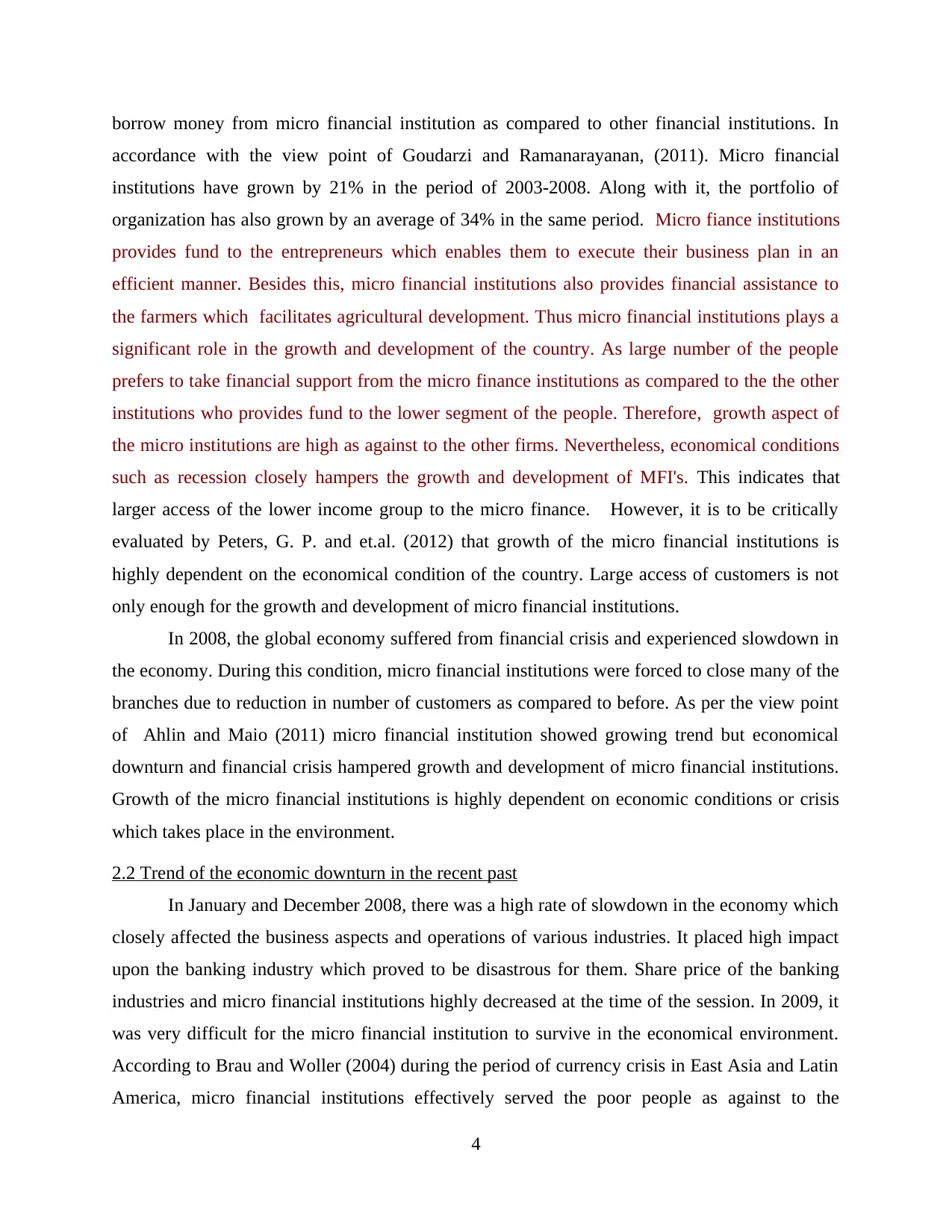
borrow money from micro financial institution as compared to other financial institutions. In
accordance with the view point of Goudarzi and Ramanarayanan, (2011). Micro financial
institutions have grown by 21% in the period of 2003-2008. Along with it, the portfolio of
organization has also grown by an average of 34% in the same period. Micro fiance institutions
provides fund to the entrepreneurs which enables them to execute their business plan in an
efficient manner. Besides this, micro financial institutions also provides financial assistance to
the farmers which facilitates agricultural development. Thus micro financial institutions plays a
significant role in the growth and development of the country. As large number of the people
prefers to take financial support from the micro finance institutions as compared to the the other
institutions who provides fund to the lower segment of the people. Therefore, growth aspect of
the micro institutions are high as against to the other firms. Nevertheless, economical conditions
such as recession closely hampers the growth and development of MFI's. This indicates that
larger access of the lower income group to the micro finance. However, it is to be critically
evaluated by Peters, G. P. and et.al. (2012) that growth of the micro financial institutions is
highly dependent on the economical condition of the country. Large access of customers is not
only enough for the growth and development of micro financial institutions.
In 2008, the global economy suffered from financial crisis and experienced slowdown in
the economy. During this condition, micro financial institutions were forced to close many of the
branches due to reduction in number of customers as compared to before. As per the view point
of Ahlin and Maio (2011) micro financial institution showed growing trend but economical
downturn and financial crisis hampered growth and development of micro financial institutions.
Growth of the micro financial institutions is highly dependent on economic conditions or crisis
which takes place in the environment.
2.2 Trend of the economic downturn in the recent past
In January and December 2008, there was a high rate of slowdown in the economy which
closely affected the business aspects and operations of various industries. It placed high impact
upon the banking industry which proved to be disastrous for them. Share price of the banking
industries and micro financial institutions highly decreased at the time of the session. In 2009, it
was very difficult for the micro financial institution to survive in the economical environment.
According to Brau and Woller (2004) during the period of currency crisis in East Asia and Latin
America, micro financial institutions effectively served the poor people as against to the
4
accordance with the view point of Goudarzi and Ramanarayanan, (2011). Micro financial
institutions have grown by 21% in the period of 2003-2008. Along with it, the portfolio of
organization has also grown by an average of 34% in the same period. Micro fiance institutions
provides fund to the entrepreneurs which enables them to execute their business plan in an
efficient manner. Besides this, micro financial institutions also provides financial assistance to
the farmers which facilitates agricultural development. Thus micro financial institutions plays a
significant role in the growth and development of the country. As large number of the people
prefers to take financial support from the micro finance institutions as compared to the the other
institutions who provides fund to the lower segment of the people. Therefore, growth aspect of
the micro institutions are high as against to the other firms. Nevertheless, economical conditions
such as recession closely hampers the growth and development of MFI's. This indicates that
larger access of the lower income group to the micro finance. However, it is to be critically
evaluated by Peters, G. P. and et.al. (2012) that growth of the micro financial institutions is
highly dependent on the economical condition of the country. Large access of customers is not
only enough for the growth and development of micro financial institutions.
In 2008, the global economy suffered from financial crisis and experienced slowdown in
the economy. During this condition, micro financial institutions were forced to close many of the
branches due to reduction in number of customers as compared to before. As per the view point
of Ahlin and Maio (2011) micro financial institution showed growing trend but economical
downturn and financial crisis hampered growth and development of micro financial institutions.
Growth of the micro financial institutions is highly dependent on economic conditions or crisis
which takes place in the environment.
2.2 Trend of the economic downturn in the recent past
In January and December 2008, there was a high rate of slowdown in the economy which
closely affected the business aspects and operations of various industries. It placed high impact
upon the banking industry which proved to be disastrous for them. Share price of the banking
industries and micro financial institutions highly decreased at the time of the session. In 2009, it
was very difficult for the micro financial institution to survive in the economical environment.
According to Brau and Woller (2004) during the period of currency crisis in East Asia and Latin
America, micro financial institutions effectively served the poor people as against to the
4
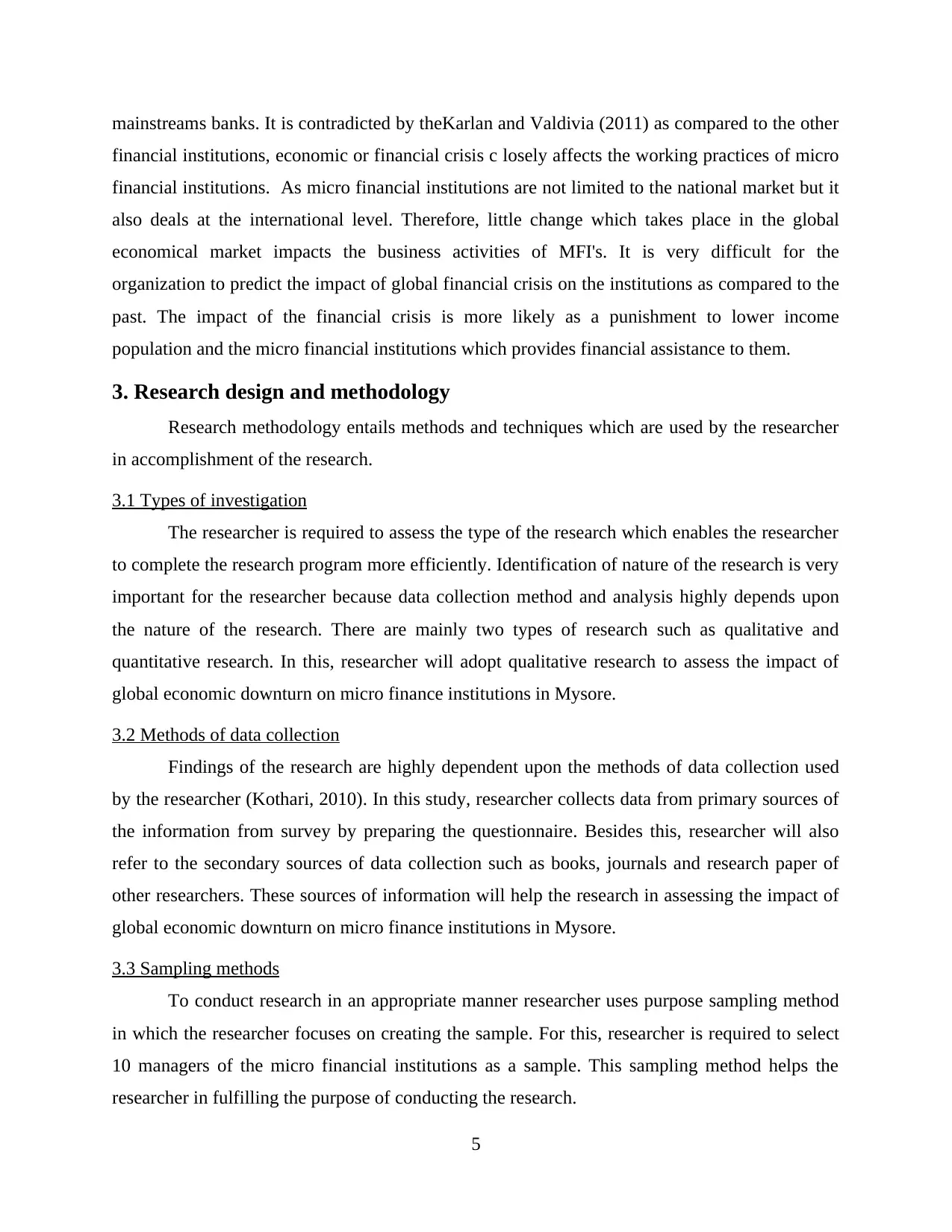
mainstreams banks. It is contradicted by theKarlan and Valdivia (2011) as compared to the other
financial institutions, economic or financial crisis c losely affects the working practices of micro
financial institutions. As micro financial institutions are not limited to the national market but it
also deals at the international level. Therefore, little change which takes place in the global
economical market impacts the business activities of MFI's. It is very difficult for the
organization to predict the impact of global financial crisis on the institutions as compared to the
past. The impact of the financial crisis is more likely as a punishment to lower income
population and the micro financial institutions which provides financial assistance to them.
3. Research design and methodology
Research methodology entails methods and techniques which are used by the researcher
in accomplishment of the research.
3.1 Types of investigation
The researcher is required to assess the type of the research which enables the researcher
to complete the research program more efficiently. Identification of nature of the research is very
important for the researcher because data collection method and analysis highly depends upon
the nature of the research. There are mainly two types of research such as qualitative and
quantitative research. In this, researcher will adopt qualitative research to assess the impact of
global economic downturn on micro finance institutions in Mysore.
3.2 Methods of data collection
Findings of the research are highly dependent upon the methods of data collection used
by the researcher (Kothari, 2010). In this study, researcher collects data from primary sources of
the information from survey by preparing the questionnaire. Besides this, researcher will also
refer to the secondary sources of data collection such as books, journals and research paper of
other researchers. These sources of information will help the research in assessing the impact of
global economic downturn on micro finance institutions in Mysore.
3.3 Sampling methods
To conduct research in an appropriate manner researcher uses purpose sampling method
in which the researcher focuses on creating the sample. For this, researcher is required to select
10 managers of the micro financial institutions as a sample. This sampling method helps the
researcher in fulfilling the purpose of conducting the research.
5
financial institutions, economic or financial crisis c losely affects the working practices of micro
financial institutions. As micro financial institutions are not limited to the national market but it
also deals at the international level. Therefore, little change which takes place in the global
economical market impacts the business activities of MFI's. It is very difficult for the
organization to predict the impact of global financial crisis on the institutions as compared to the
past. The impact of the financial crisis is more likely as a punishment to lower income
population and the micro financial institutions which provides financial assistance to them.
3. Research design and methodology
Research methodology entails methods and techniques which are used by the researcher
in accomplishment of the research.
3.1 Types of investigation
The researcher is required to assess the type of the research which enables the researcher
to complete the research program more efficiently. Identification of nature of the research is very
important for the researcher because data collection method and analysis highly depends upon
the nature of the research. There are mainly two types of research such as qualitative and
quantitative research. In this, researcher will adopt qualitative research to assess the impact of
global economic downturn on micro finance institutions in Mysore.
3.2 Methods of data collection
Findings of the research are highly dependent upon the methods of data collection used
by the researcher (Kothari, 2010). In this study, researcher collects data from primary sources of
the information from survey by preparing the questionnaire. Besides this, researcher will also
refer to the secondary sources of data collection such as books, journals and research paper of
other researchers. These sources of information will help the research in assessing the impact of
global economic downturn on micro finance institutions in Mysore.
3.3 Sampling methods
To conduct research in an appropriate manner researcher uses purpose sampling method
in which the researcher focuses on creating the sample. For this, researcher is required to select
10 managers of the micro financial institutions as a sample. This sampling method helps the
researcher in fulfilling the purpose of conducting the research.
5
⊘ This is a preview!⊘
Do you want full access?
Subscribe today to unlock all pages.

Trusted by 1+ million students worldwide
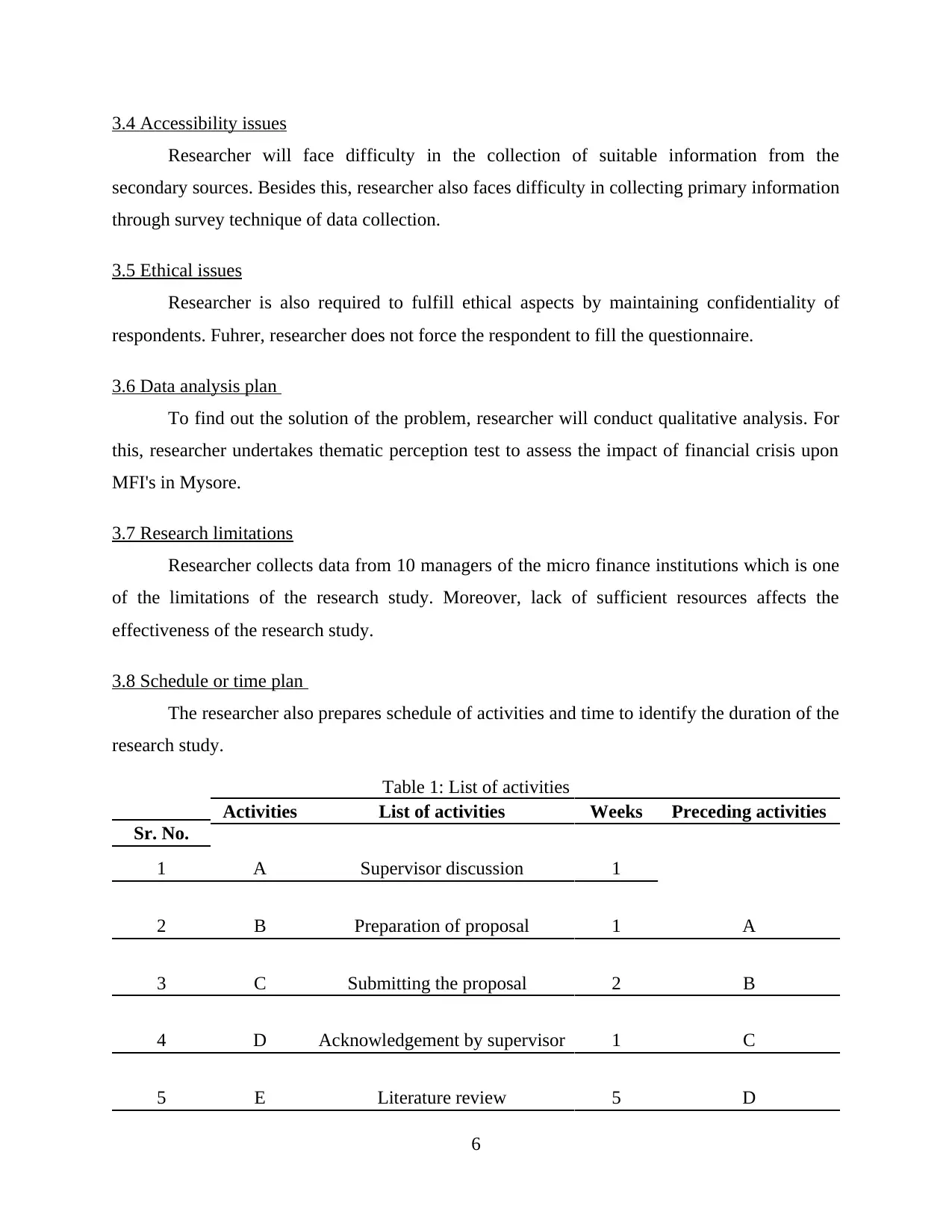
3.4 Accessibility issues
Researcher will face difficulty in the collection of suitable information from the
secondary sources. Besides this, researcher also faces difficulty in collecting primary information
through survey technique of data collection.
3.5 Ethical issues
Researcher is also required to fulfill ethical aspects by maintaining confidentiality of
respondents. Fuhrer, researcher does not force the respondent to fill the questionnaire.
3.6 Data analysis plan
To find out the solution of the problem, researcher will conduct qualitative analysis. For
this, researcher undertakes thematic perception test to assess the impact of financial crisis upon
MFI's in Mysore.
3.7 Research limitations
Researcher collects data from 10 managers of the micro finance institutions which is one
of the limitations of the research study. Moreover, lack of sufficient resources affects the
effectiveness of the research study.
3.8 Schedule or time plan
The researcher also prepares schedule of activities and time to identify the duration of the
research study.
Table 1: List of activities
Sr. No.
Activities List of activities Weeks Preceding activities
1 A Supervisor discussion 1
2 B Preparation of proposal 1 A
3 C Submitting the proposal 2 B
4 D Acknowledgement by supervisor 1 C
5 E Literature review 5 D
6
Researcher will face difficulty in the collection of suitable information from the
secondary sources. Besides this, researcher also faces difficulty in collecting primary information
through survey technique of data collection.
3.5 Ethical issues
Researcher is also required to fulfill ethical aspects by maintaining confidentiality of
respondents. Fuhrer, researcher does not force the respondent to fill the questionnaire.
3.6 Data analysis plan
To find out the solution of the problem, researcher will conduct qualitative analysis. For
this, researcher undertakes thematic perception test to assess the impact of financial crisis upon
MFI's in Mysore.
3.7 Research limitations
Researcher collects data from 10 managers of the micro finance institutions which is one
of the limitations of the research study. Moreover, lack of sufficient resources affects the
effectiveness of the research study.
3.8 Schedule or time plan
The researcher also prepares schedule of activities and time to identify the duration of the
research study.
Table 1: List of activities
Sr. No.
Activities List of activities Weeks Preceding activities
1 A Supervisor discussion 1
2 B Preparation of proposal 1 A
3 C Submitting the proposal 2 B
4 D Acknowledgement by supervisor 1 C
5 E Literature review 5 D
6
Paraphrase This Document
Need a fresh take? Get an instant paraphrase of this document with our AI Paraphraser
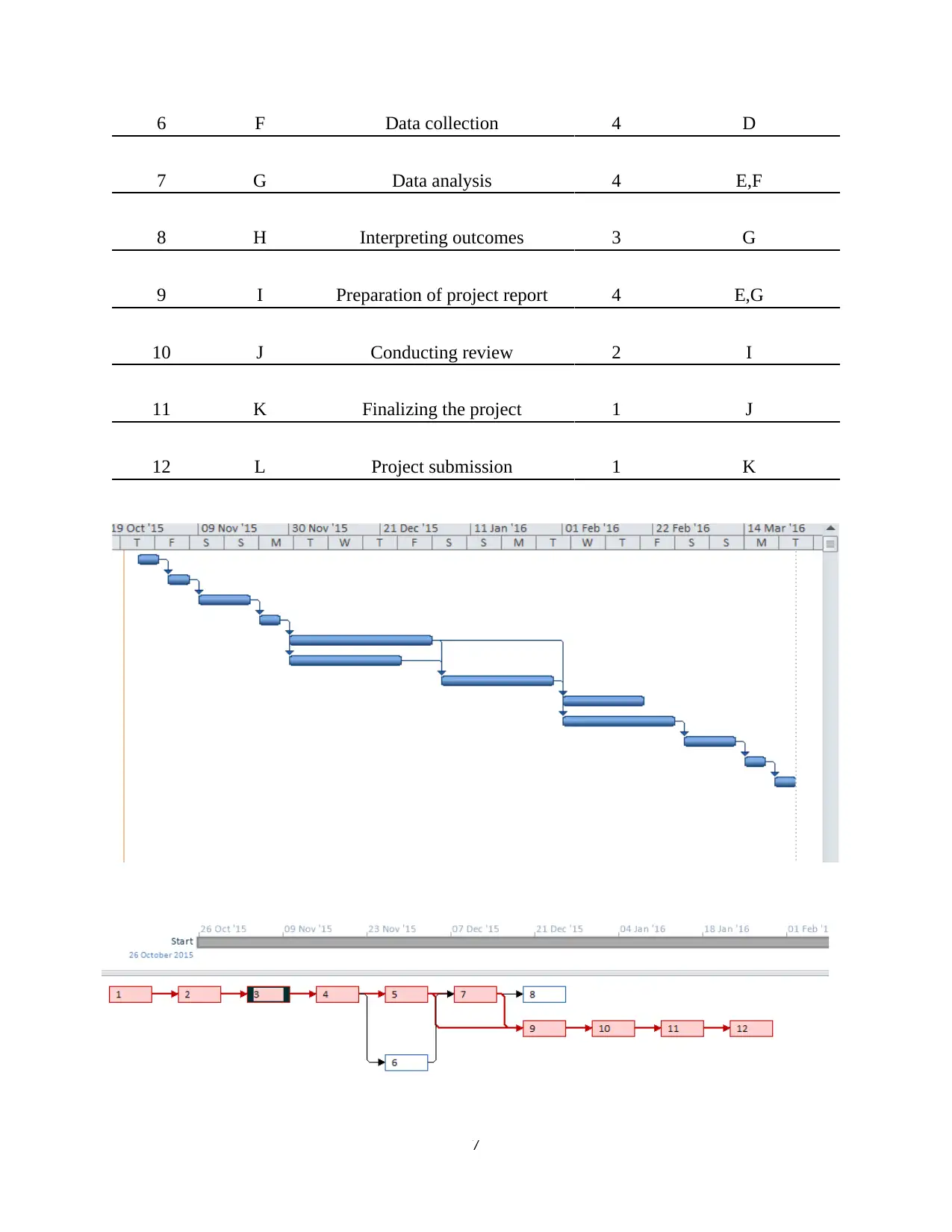
6 F Data collection 4 D
7 G Data analysis 4 E,F
8 H Interpreting outcomes 3 G
9 I Preparation of project report 4 E,G
10 J Conducting review 2 I
11 K Finalizing the project 1 J
12 L Project submission 1 K
7
7 G Data analysis 4 E,F
8 H Interpreting outcomes 3 G
9 I Preparation of project report 4 E,G
10 J Conducting review 2 I
11 K Finalizing the project 1 J
12 L Project submission 1 K
7
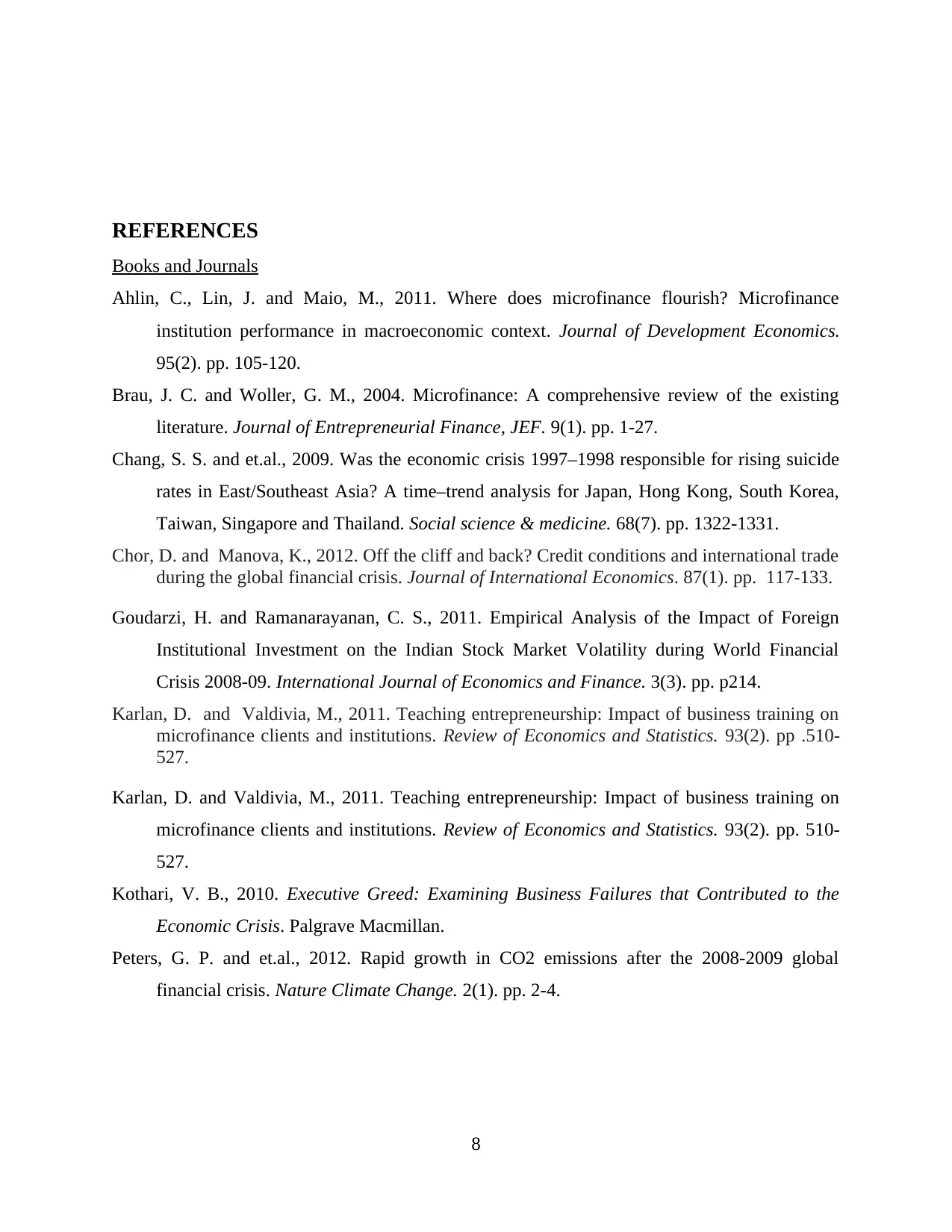
REFERENCES
Books and Journals
Ahlin, C., Lin, J. and Maio, M., 2011. Where does microfinance flourish? Microfinance
institution performance in macroeconomic context. Journal of Development Economics.
95(2). pp. 105-120.
Brau, J. C. and Woller, G. M., 2004. Microfinance: A comprehensive review of the existing
literature. Journal of Entrepreneurial Finance, JEF. 9(1). pp. 1-27.
Chang, S. S. and et.al., 2009. Was the economic crisis 1997–1998 responsible for rising suicide
rates in East/Southeast Asia? A time–trend analysis for Japan, Hong Kong, South Korea,
Taiwan, Singapore and Thailand. Social science & medicine. 68(7). pp. 1322-1331.
Chor, D. and Manova, K., 2012. Off the cliff and back? Credit conditions and international trade
during the global financial crisis. Journal of International Economics. 87(1). pp. 117-133.
Goudarzi, H. and Ramanarayanan, C. S., 2011. Empirical Analysis of the Impact of Foreign
Institutional Investment on the Indian Stock Market Volatility during World Financial
Crisis 2008-09. International Journal of Economics and Finance. 3(3). pp. p214.
Karlan, D. and Valdivia, M., 2011. Teaching entrepreneurship: Impact of business training on
microfinance clients and institutions. Review of Economics and Statistics. 93(2). pp .510-
527.
Karlan, D. and Valdivia, M., 2011. Teaching entrepreneurship: Impact of business training on
microfinance clients and institutions. Review of Economics and Statistics. 93(2). pp. 510-
527.
Kothari, V. B., 2010. Executive Greed: Examining Business Failures that Contributed to the
Economic Crisis. Palgrave Macmillan.
Peters, G. P. and et.al., 2012. Rapid growth in CO2 emissions after the 2008-2009 global
financial crisis. Nature Climate Change. 2(1). pp. 2-4.
8
Books and Journals
Ahlin, C., Lin, J. and Maio, M., 2011. Where does microfinance flourish? Microfinance
institution performance in macroeconomic context. Journal of Development Economics.
95(2). pp. 105-120.
Brau, J. C. and Woller, G. M., 2004. Microfinance: A comprehensive review of the existing
literature. Journal of Entrepreneurial Finance, JEF. 9(1). pp. 1-27.
Chang, S. S. and et.al., 2009. Was the economic crisis 1997–1998 responsible for rising suicide
rates in East/Southeast Asia? A time–trend analysis for Japan, Hong Kong, South Korea,
Taiwan, Singapore and Thailand. Social science & medicine. 68(7). pp. 1322-1331.
Chor, D. and Manova, K., 2012. Off the cliff and back? Credit conditions and international trade
during the global financial crisis. Journal of International Economics. 87(1). pp. 117-133.
Goudarzi, H. and Ramanarayanan, C. S., 2011. Empirical Analysis of the Impact of Foreign
Institutional Investment on the Indian Stock Market Volatility during World Financial
Crisis 2008-09. International Journal of Economics and Finance. 3(3). pp. p214.
Karlan, D. and Valdivia, M., 2011. Teaching entrepreneurship: Impact of business training on
microfinance clients and institutions. Review of Economics and Statistics. 93(2). pp .510-
527.
Karlan, D. and Valdivia, M., 2011. Teaching entrepreneurship: Impact of business training on
microfinance clients and institutions. Review of Economics and Statistics. 93(2). pp. 510-
527.
Kothari, V. B., 2010. Executive Greed: Examining Business Failures that Contributed to the
Economic Crisis. Palgrave Macmillan.
Peters, G. P. and et.al., 2012. Rapid growth in CO2 emissions after the 2008-2009 global
financial crisis. Nature Climate Change. 2(1). pp. 2-4.
8
⊘ This is a preview!⊘
Do you want full access?
Subscribe today to unlock all pages.

Trusted by 1+ million students worldwide
1 out of 9
Related Documents
Your All-in-One AI-Powered Toolkit for Academic Success.
+13062052269
info@desklib.com
Available 24*7 on WhatsApp / Email
![[object Object]](/_next/static/media/star-bottom.7253800d.svg)
Unlock your academic potential
Copyright © 2020–2025 A2Z Services. All Rights Reserved. Developed and managed by ZUCOL.




